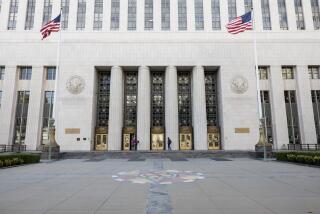Globe-Spanning Court Is in Session
WILLIAMSBURG, Va. â From a college in England, a barrister questions his star witness, an aging green-haired hippie whose answers are beamed across the globe from Australia. Jurors murmur with surprise as prosecutors re-create an in-flight jet collision with lifelike digital animation.
And a judge supervises it all from Virginia--at times talking to a camera that transmits his image to the prosecutor across the ocean, watching on a monitor.
The courtroom of the future--complete with two-way remote testimony, three-dimensional images of evidence and automatic speech transcription--had its first mock trial recently.
The April experiment from Courtroom 21 in this colonial American town got positive reviews, despite a few technical glitches.
âIt was a remarkable experience, and the people here have done a great service to the courts,â said James Rosenbaum, a federal judge in Minneapolis who volunteered to preside.
The fake case involved a terrorist bomb attack aboard a U.S. military plane, which then collided in the air with a civilian airliner.
The trialâs organizers said their goal wasnât just to show off technology but to explore issues like usability, fairness and ethics.
âWeâre doing it to learn what happens when you use all the technology available at our disposal to determine the legal and ethical questions that occur when you have a high-stakes case,â said Fred Lederer, director of Courtroom 21 at the College of William & Maryâs law school.
Courtroom 21 is ringed with flat plasma television screens, including one behind the witness stand and one at the prosecutorâs desk, and smaller LCD monitors are installed on every desktop.
Several camera domes hang from the ceiling to record and project every move, and every document and piece of evidence can be digitally projected on monitors for the jurors and audience in the room or on the other side of the world.
Although futuristic, some of the technology already is in use.
Lederer said 300 to 500 high-tech courtrooms are in use in the United States and Australia. Ledererâs courtroom was used as a model for the War Crimes Tribunal in the Netherlands, and his team is working with the Federal Judicial Center to develop a handbook about courtroom technology for judges and lawyers.
The crucial evidence of the trial, a photo-realistic animation, held the courtroom stunned by its authenticity.
The video depicted a U.S. Air Force cargo plane and a passenger jet flying over London, both dodging violent weather and moving within several hundred feet of each other. Suddenly a small bomb on the military plane explodes, hurtling the disabled aircraft into the civilian airliner in a catastrophic collision that rains debris over downtown London.
Joe Reynolds, chairman of the Annapolis, Md.-based FTI Consulting, which created the animation, said his company has designed thousands of courtroom animations for all types of cases.
âA three-dimensional moving object is so powerful for a jury to understand, and we find when itâs used properly--and it has to be admitted by the court--it can be a very useful part of the presentation,â Reynolds said.
More traditional technologies also were used, such as a mechanical Braille reader to assist a blind witness and a live language translation service.
There were several computer presentations, including one that showed a 3-D model of a chemical compound that could be rotated with the touch of a finger.
Rosenbaum, the judge, already has some high-tech experience. His courtroom in Minneapolis is wired to allow remote testimony by video.
âI have found that they work very well, that juries are completely accepting of it, and that once they get used to it the lawyers like it a great deal,â Rosenbaum said.
âI find it speeds up cases and makes them more comprehensible,â he said.
Rosenbaum said video teleconferencing is commonly used in appeals cases and is gaining acceptance in civil litigation. Due to the right of defendants to confront accusers, however, Rosenbaum and many other judges are reluctant to allow them in criminal situations.
âItâs easy to call you a rat behind your back, itâs real easy to call you a rat from a thousand miles away,â Rosenbaum said. âBut itâs a lot harder when weâre nose to nose.â
The trial wasnât glitch-free.
Audio from the three continents sometimes was delayed, hampered by echo or too soft to be heard. Student lawyers sometimes fumbled with high-tech gadgets.
But the participants still had to remind themselves the trial wasnât real.
âRight now we are impressed it worked at all,â Lederer said. âConsidering what we thought might happen, it was incredibly good.â
*
Courtroom 21: https://www.courtroom21.net
More to Read
Sign up for Essential California
The most important California stories and recommendations in your inbox every morning.
You may occasionally receive promotional content from the Los Angeles Times.










